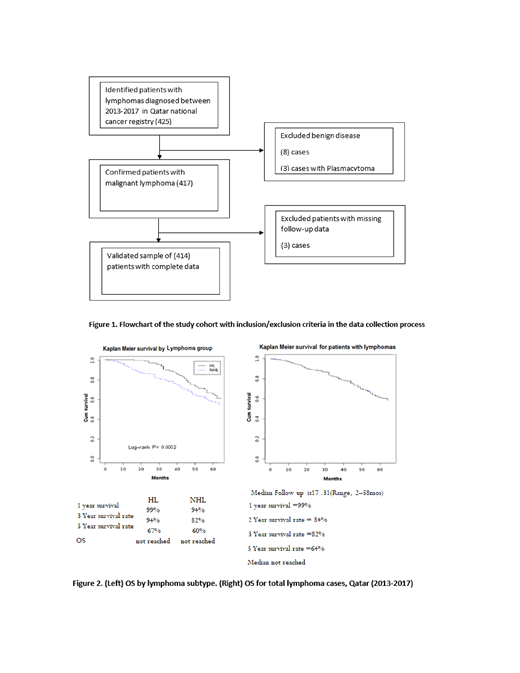Abstract
Background:
Lymphoma: either most common non-Hodgkin (NHL) or less common Hodgkin (HL), are well-known hematological malignancies. With advancement in treatment modalities, the survival in both lymphomas especially the "poor prognosis" non-Hodgkin lymphoma has evolved in the last decades. Hence, patient's outcome may be diverse and quite complicated; with some need extended time for observation, and others having multiple chemotherapy treatments. In this review, we will focus on the clinic-epidemiological patterns of various malignant lymphoma subtypes in Qatar in recent years (2013-2017)
Objective:
The primary aim is to investigate and compare the overall survival (OS) for both types of lymphoma; HL and NHL at 1, 3 and 5-years of follow up in adult lymphoma patients in Qatar between January 2013 - December 2017. Other objectives include comparing between the most frequent histological varieties, clinical and epidemiological characteristics of HL and NHL lymphoma in Qatar. The secondary objectives included clinical characteristics, treatments used, treatment response, disease-free survival and overall survival.
Methods:
A retrospective, descriptive study of consecutive cases was carried out at NCCCR, Qatar between 2013-2017. Inclusion criteria included: ≥ 18 years of age, male or female, any clinical stage at diagnosis, who had received any chemotherapy regimen, with a known outcome. Descriptive statistics was performed for all variables, and survival was assessed using Kaplan-Meier curves. Data was abstracted by Qatar National Cancer Registry and the 2008 World Health Organization (WHO) classification of hematopoietic and lymphoid tumors is used as reference for disease staging and pathological classification. We used STATA version 13.0 (StataCorp., College Station, TX) for exploratory data analysis and descriptive statistics.
Results:
During the period 2013-2017, 414 men and women were diagnosed with lymphoma in the state of Qatar. The median age at diagnosis being 49 years (interquartile range IQR 36-95 years; p<0.001)) for all lymphoma patients combined. Males were more likely to develop both lymphoma types; HL and NHL than females; accounting for 2/3 of cases in each, yet statistically insignificant (74% and 70%, p=0.45). Based on subtypes, mature B-cell neoplasms (61 cases, 60%) were the most common among 13 identifiable NHL-B subtypes. Majority of HL cases belonged to Lymphocyte rich subtype (54 cases, 49%). With a median follow up of 17.3 months, the 1-year, 3-year and 5-year OS for the entire population of lymphoma patients were 99%, 82% and 64% (Figure 12). When stratified by major subtypes; HL and NHL, some trends became evident at 3-years follow-up (94% versus 82%). The 5-year OS were 67% and 60%, respectively. Throughout the study period, the OS in HL group were higher than NHL (p<0.001), yet median OS was not reached.
Conclusions:
Diffuse large B-cell lymphoma constitutes the most frequent subtype for all lymphomas in Qatar. Overall, the survival was generally better for HL than NHL 67% and 60% respectively. Survival can be slightly deflated than other countries or regions especially HL, this is in part due to higher immigration rate in the country, so changes in survival over time (especially for longer periods) need to be examined alongside trends in incidence rates to interpret improvement in cancer control policies implemented.
No relevant conflicts of interest to declare.


This feature is available to Subscribers Only
Sign In or Create an Account Close Modal